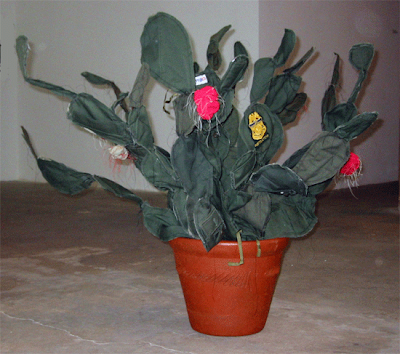
One of the presenters at the Feminist Art Project seminar at the College Art Association's conference in Chicago was Margarita Cabrera. I was very impressed with her work because of the integration of social content/mission and aesthetics.
She was born in Mexico and mostly raised in the US - living in Texas and New York City. She moved to El Paso and was motivated by the horrific murders of young women in Juarez (just across the border) to do something. Part of the thing was that there were many new factories being built just inside Mexico and the young women were being employed to work there. The perpetrators may have wanted to the jobs for themselves? Most of the cases have gone unsolved. From a Special Report, "The impunity in which such crimes are then left sends the message that such violence is tolerated, thereby fueling its perpetuation."
Margarita Cabrera started various art projects. One of the earlier ones were the appliances such as blenders and vacuums. These were the sorts of things being build in the factories. Her treatment was to make them out of vinyl and with loose strings so they end up looking sad and floppy - and rather undone. She also moved on to making VW Beetles - also made in Mexico.

As she did this - she had the need of helpers and she was able to employ some of the unemployed women of the area.
She also had a project where she got women making copper monarch butterflies - what with the monarchs that return to Mexico each winter. She has had installations with thousands of the butterflies. It has also been about teaching people skills and having a reason to make the things.
One of her newer projects (from her page):
SPACE IN BETWEEN is a collaborative project in the form of a sewing and embroidery workshop at Houston’s Box 13 Gallery. The title is inspired by the term Nepantla, which in the Nahuatl Aztec Language references “the space in the middle” as it relates to marginalized cultures and their resistance strategies of survival. Gloria Anzaldua, scholar, activist, and author of Borderlands/La Frontera, views Nepantla as a reference to living in the borderlands or crossroads, and the process of creating alternative spaces in which to live, function, or create.
Cabrera’s work continues an ongoing exploration of the defining economic relationship between the United States and Mexico. She is interested in creating an aesthetic platform for political and social-cultural consciousness as a means of survival.
The project is structured in three parts:
First, given the history of the BOX13 space as a SINGER sewing machine showroom, sewing school and repair/factory, a community workshop will produce numerous sculptural replicas of desert plants that are indigenous to the Southwestern United States, the most frequently traveled route of immigration into the U.S. Sewn together out of border patrol uniforms, and planted in traditional Mexican terra cotta pots, these sculptural plants render the role of border patrol officers as the protagonists in the American landscape.
A second focus is the attempt to re-introduce and/or maintain an ethnic connection with vital cultural Mexican craft traditions. Members of migrating communities from Mexico living in the Houston Community will be invited to work with traditional sewing and embroidery techniques from Los Tenangos, Hidalgo, Mexico. Traditionally in mural form, the embroidery from Tenango de Doria Hidalgo, employs colorful narrative renditions reflecting popular culture, traditional rituals and myths of the Otomi indigenous communities. Sometimes appropriating and other times reclaiming these techniques, immigrant workers will use it to relay their own personal border crossing experience. This embroidered narrative element will be combined in creative ways with the desert plants.
Thirdly, the production areas are divided into four parts consisting of a cutting area, a sewing area, an embroidery area, and a construction area.
The work being produced and gradually displayed is primarily made from Border Patrol uniforms resulting in sculptures that represent desert plants that embody personal immigrant stories. The workers sharing in this labor and its rewards (Cabrera is sharing proceeds from sales with the craftsmen/women) are coming to this project from *The Houston Interfaith Worker Justice Center.
.jpg)

No comments:
Post a Comment